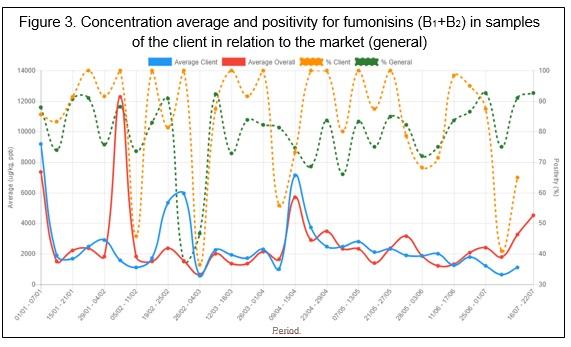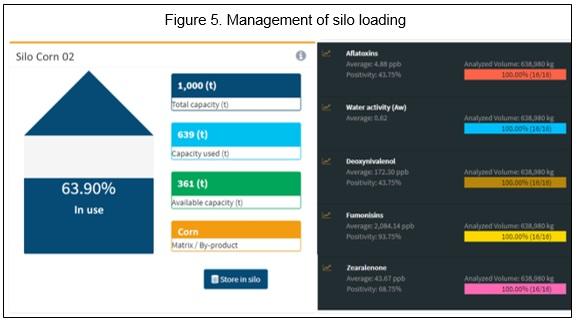Managing mycotoxins at the speed of light
Published: July 30, 2018
By: Prof. Dr. Mallmann (LAMIC - Federal University of Santa Maria), MSc. Denize Tyska, Zoot, PhD Student (LAMIC - Federal University of Santa Maria), Dr. MSc. MV. Adriano O. Mallmann (Pegasus Science)
Pegasus, in the Greek mythology, was the winged stallion that carried the thunderbolts of Zeus. Thunderbolts represent light and speed, simultaneously. To obtain speed in the risk management of mycotoxins is, today, a reality within the field of business.
Management of mycotoxins
The technical concepts that involve the animal losses caused by the mycotoxins have already been established, especially for those species with an economic value. Proper monitoring of mycotoxins goes beyond the analysis per se. The control of the raw material is attained through the interpretation of the analytical data along the time as well as a series of complex biological aspects, which generate the “Mycotoxins Risk”. Nevertheless, one of the limiting factors in the process thus far was the promptness of decision-making, what is only possible with access to rapid diagnostic tools. Recently, the fast, simple and low-cost technology for the detection of mycotoxins that employs near-infrared spectroscopy – NIR was created.
Application of the NIR technology for mycotoxins analysis
NIR is a highly precise tool which emits electromagnetic radiation. The energy absorption is derived from the organic compounds which are present in the sample, and may be used to reach a direct or indirect estimation of the concentration of a substance. The technique encompasses the integration of a database obtained through analyses carried out by traditional methodologies (wet chemistry) and the spectral evaluations. This information is subjected to chemometric methods, and the prediction equations are then produced.
The advantage of the NIR technology for control and monitoring comparing to other methods is the readiness with which the sample is prepared and analyzed. There is no need for reagents, pipetting or extractions, but merely grinding and reading of the spectrum in the NIR equipment, with the result being released in no time. It is, therefore, a unique technology which permits fast decision-making. However, the success in the elaboration of prediction equations resides in the accuracy of the reference methods, since the primary analytical technique must be in compliance with ISO 17.025 (accredited by official organizations) due to the complexity of mycotoxins determination. Moreover, sets of samples with concentrations of mycotoxins that reflect the reality in the field must be used, a process which requires a database with hundreds of samples selected for an extended period of time.
Predictions by the NIR technology are currently available for the most prevalent mycotoxins in the main ingredients of animal feedstuffs and human nutrition (Figure 1). Such prediction equations via NIR have been developed using the most sensitive technique for the analysis of mycotoxins available today, Liquid Chromatography Coupled to Tandem Mass Spectrometry (LC-MS/MS), as a reference.

System of information interpretation
A digital platform with an interface of easy interpretation is required for interpreting the information by means of an online analyses system, which is available 24 hours and provides instant results. The user must only possess a NIR equipment and a grinder for sample preparation in the production plant. The process is remarkably simple and speedy: it consists of sampling grains from the lot, grinding, homogenizing, filling the reading cell of the NIR equipment with an aliquot of the sample, reading of the spectrum and, to conclude, loading the file with the spectrum into the system of rapid interpretation.

The system immediately provides the results, besides statistical graphics that aid in obtaining information for the decision-making. The prevalence and the average of mycotoxins concentration in the analyzed samples in relation to samples that constitute the main databases involved in the process are visualized in the graphs (Figure 3).
 The Mycotoxins Risk is calculated based on each mycotoxin historical monitoring, in addition to factors as species susceptibility, age, sex and exposure to sanitary, environmental and nutritional aspects. Figure 4 illustrates the past and current Risk for aflatoxin in a poultry-producing company. The Mycotoxins Risk indicates the moment at which decision-making is mandatory in order to minimize the impact of mycotoxins on the production system.
The Mycotoxins Risk is calculated based on each mycotoxin historical monitoring, in addition to factors as species susceptibility, age, sex and exposure to sanitary, environmental and nutritional aspects. Figure 4 illustrates the past and current Risk for aflatoxin in a poultry-producing company. The Mycotoxins Risk indicates the moment at which decision-making is mandatory in order to minimize the impact of mycotoxins on the production system.
Another tool which is available to help in the quality control of the stocks of raw materials is the possibility of managing silo filling load by load. In this way, a database of the silo is built and populated with information on toxicology and water activity Aw, thus making it possible to segregate the raw materials and to determine the animal category or the decision-making of adding an anti-mycotoxin additive to the produced diet (Figure 5).

Conclusion
Innovative solutions with an actual vision of science in mycotoxins are, for the first time, a reality. The NIR technology for the analyses of mycotoxins bears several technical advantages, besides enabling the management and control of the stocks in real time for a cost-benefit which cannot be surpassed by any other technology. Most definitely, the presentation of the Mycotoxins Risk in the current format is the state of art in the complex system of mycotoxins management.
Related topics:
Authors:
Pegasus Science
LAMIC - LABORATORY OF MYCOTOXICOLOGICAL ANALYSIS
Pegasus Science
Recommend
Comment
Share
7 de agosto de 2018
Toxigenic strains of fungi are ubiquitous. Can we develop technology to make our planet free from toxigenic fungi and nurture only useful fungi?
Recommend
Reply
Iowa State University
6 de agosto de 2018
NIR does not measure mycotoxins; they are at concentrations below the resolution of the instruments. NIR responds statistically to changes in structure that in a given sample set are correlated with the toxin value. The problem is that in another sample set, from another area or growing season, those correlations have been very inconsistent, and therefore not predictive.
Recommend
Reply

Would you like to discuss another topic? Create a new post to engage with experts in the community.









